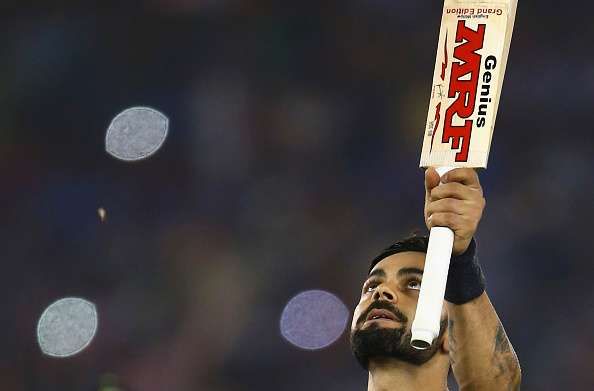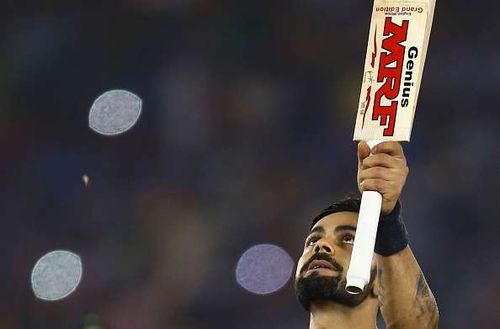
The new king of cricket - Virat Kohli
Virat Kohli’s emergence as India’s numero uno batsmen has ensured a seamless transition from the era of Sachin Tendulkar. While an ODI average of 52 and a T20 average of 55 (seriously?) mark him out as one of the best, if not the best, limited overs’ batsmen in the world.
His meaning to the Indian national team extends far beyond a set of numbers of uncertain value. He is a unique combination of Dhoni and Tendulkar, the finisher and the master that is both unprecedented and so special that it makes your heart sing.
Simply put, he would have been India’s answer to the question,”If Shakespeare had been a cricketer what would he be like?”. His batting has the serenity of a poet’s dream and the flair of a dramatist, a combination as unique as Shakespeare still is four centuries hence.
We just watched three of the best batting masterclasses ever, all by him, twice against Pakistan and once against Australia. T20, a format for the batsmen, is not meant to produce a masterclass in batting itself. It is the bowlers who can awe and surprise us with a defiance of the batsmen when they were widely expected to meekly surrender to the overpowering enemy.
But circumstances contrived to produce a match which required a Phoenix to rise from the ashes of the dead and to lead the country home which is when Virat Kohli answered the call.
As he started his innings in that Asia Cup match against Pakistan, a deadly combination of a seaming pitch and Mohammad Amir produced conditions so scorching hot that all that the Indian batsmen could do was keep their head on their shoulders and hope the balls miss the wicket. But Kohli is no meek opponent. Always ready for a fight, he was supposed to be roast on a pitch where according to most, batting had become a mere game of chance.
But it is during those times that those with a mental fortitude as tough as steel come to the fore to show mere mortals like us how the gods would have done it. As Virat strode out onto the wicket majestically two deliveries from the irrepressible Amir had already produced two certain lbw shouts (one given). The first delivery he faced was safely guided for a single. But to his, and everybody in India’s horror, like a magician with a single trick of the hat Amir, conjured two more wickets.
But the undefeatable went on, safely negotiating even the most venomous balls with the quickness of a snake wrangler and the eye of an eagle. As everyone paid their respects to the newly anointed king of cricket, the new king showed his class by dispatching Amir twice to the boundary.
The second pitch in Kolkata could not have been more different than the first. A pitch with so much turn that it almost seemed it was taking revenge from the Mirpur pitch for being so seaming, the results followed the same well-trodden territory.
As Pakistan finished their innings and the Indian batsmen strode out onto the wicket, the chase seemed to be ordinary enough for batsmen who knew spinning pitches like the back of their hand. But as the Pakistani batsmen showed, the art of batting on difficult pitches is not the same art as that of a 10-year-old schoolgirl. It’s the art of a Picasso, a Van Gogh, a Cezanne, only those who have experienced it can understand it.
And Kohli, the supreme practitioner of the art, once again saved the day (or night) with a measured innings.
The last innings in Mohali was another poetry in motion. More than the sixes and the boundaries that he hit, Kohli’s composure, his unfailing belief in his own ability, his assuredness and his sheer class stand out as distinct memories from this innings against Australia.
If you want to see a shot that epitomizes Kohli the batsman look no further than his six off Faulkner in the chase. The shot’s indelible memory is the ball hanging in the air seemingly unwilling to come down before it makes its way past the boundary in spite of the first-hand impression that he had only chipped the ball.
The Australians are some of the fiercest competitors on the planet but even they had to concede the point that some forces of nature are overwhelmingly powerful and cannot be subverted. All you can do in their face is to stand tall and hope that the gales pass.
As he answered the clarion call of the Indian supporters thrice, he gave clear and incontrovertible evidence of his greatness as a batsman. Even if he were to retire tomorrow, the king would live like a star in the eyes of those who have witnessed him wield the willow like a magic wand. Metaphors fail him as he is an incomparable diamond whose sparkle is soothing to the eye.
But as the match against New Zealand showed, even the greatest sometimes fail but unfortunately for India, the failure of Kohli seemed to bring a feeling of inevitability of an Indian defeat, always a bad sign for a team of India’s caliber and expectation. While it’s good to have the darling of a billion hearts in your team, the game of cricket is cruel and will punish you if you don’t put your house in order.
This, of course, takes away nothing from the subject of this article today, Virat Kohli, the doyen of the present era of batsmanship. May the king have a long reign.
